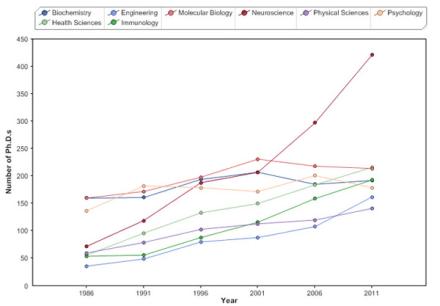Neuroscience is experiencing a period of impressive growth and is attracting the brightest and most enthusiastic students of any area of science. The number of NIH-supported trainees graduating with a Ph.D. in neuroscience has sky-rocketed since 2001. These young scientists will make new discoveries and answer questions that now seem intractable. New programs like the BRAIN Initiative have injected new enthusiasm and opportunities for discovery into our field. But our growth puts additional emphasis on the need to provide the training and mentorship that is crucial to maximizing the scientific output of our workforce.

The challenge of our good fortune is that we must now augment the dialogue on how to efficiently and effectively support the career development of our trainees. If we hope to sustain wide-reaching support for neuroscience, the most critical element is high quality mentoring. It takes considerable time and energy on the part of the mentor and this essential component needs to be tracked and rewarded by the University departments. Training the neuroscience workforce is so important that it should be embraced broadly by the entire neuroscience community, not only at the level of the lab chief but in the neuroscience departments, the Universities, the neuroscience societies, Federal funders, biomedical industries, disease-related organizations and other non-profit foundations and philanthropists. In the last week of October, I joined colleagues and trainees from the government, public, and private sectors at a workshop on Defining the Expertise Needed for the 21st Century Neuroscience Workforce hosted by the Institute of Medicine. We shared best practices, hurdles we are working to overcome, and ideas of how to implement improvements in neuroscience training across the entire community – some of which I highlight below.
There are numerous ways that NINDS hopes to work with the greater neuroscience community to ensure that neuroscience trainees gain the necessary skills to advance the fundamental study of the brain and its associated disorders. In a period exploding with new techniques, expansive “big data” sets, and increased reliance on programming, we cannot ignore the changing needs and opportunities for neuroscience training. The importance of quantitative skills must not be understated; in fact, some have suggested that a new training paradigm is necessary to impart these skills, particularly for statistical analyses. As new techniques deliver reams of raw data, scientists who lack sufficient statistical experience risk increased errors in data analysis and inaccurate conclusions, which will impede the progress of discovery and therapy development. NINDS has already emphasized our dedication to improving and defining good research practices through our scientific rigor initiatives and we look forward to the proposals for the training modules to enhance data reproducibility that are in process of submission. Most believe that training in the rigorous, quantitative and high quality experimental science is the solution, and recently Drs. Balice-Gordon and Stewart published a veritable guidebook on the subject. Also highlighted at the Training the Neuroscience Workforce meeting was a need to foster more sophisticated writing skills. Writing skills are essential in communicating one’s science to colleagues and a wide variety of stakeholders, including the lay public. Certainly grant-writing skills are critical for obtaining funding from NIH and other sources.
Given the great diversity of neuroscience research and the complexity of understanding the basic principles of the brain, it is often essential that trainees and experienced scientists work in interdisciplinary teams. We need the combined efforts of those with expertise across mathematics, biology, engineering, computational modeling, and physics – to name a few. Of course, team science presents its own set of complexities, including appropriate crediting of contributions of trainees in group publications. To solve the special set of problems associated with team science, we must identify best practices for motivating new and senior researchers to integrate their skills and share data into a team environment that benefits all.
We must not presume to know from where the next great discovery will arise and, accordingly, we must work to systematically disseminate the latest knowledge in a way that optimally engages young scientists. Indeed, we should engage those in training to help with this endeavor, as they’ve grown up in, and are much more facile with, an interconnected electronic world. Perhaps we can utilize web-based education, i.e. MOOCs (massive open online courses), more effectively. To share data and tools like the Brain Explorer, the Allen Brain Institute holds workshops and symposia, and is developing online training mechanisms to foster a culture of life-long learning among scientists. Through the BRAIN Initiative, NINDS is working with nine other NIH Institutes and Centers to develop and implement numerous short-courses that prepare participants to use and adapt the latest state-of-the-art technologies and methods, including those for computational and quantitative analyses. Standardizing data sharing and education will not only prepare neuroscientists of today and tomorrow with the expertise necessary to explore the brain, but will help maintain a broad interest and investment that encourages students to engage in neuroscience for decades to come.
